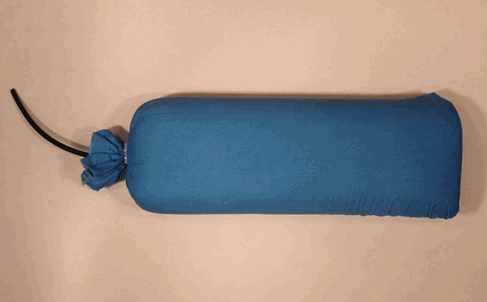Bagged Underground Reference Electrodes
Standard design underground reference electrodes, also known as bagged electrodes, are the original reference electrode design for permanent underground applications. They remain in widespread use today because they have proven long term durability. The reference electrode is contained in a cotton bag filled with bentonite-gypsum backfill. Since the entire surface of the bag is in contact with the surrounding soil, there is very low earth contact resistance. This is the primary reason that bagged electrodes are the preferred design for use in high resistance semi-dry soils or locations with seasonal dry periods.

Bagged electrodes are easily installed at new construction sites where there is an open excavation or at existing locations in a bore hole. After the electrode has been placed in the hole, it is covered with about 5 cm (2 inches) screened local backfill and then saturated with about 20 liters (5 gallons) potable water to activate it. The potential of the electrode should be checked against a portable electrode of known accuracy before the hole is backfilled.
EDI’s LongLife Reference Electrode (Model UL) has a 30 year design life. It is considered to be the premium reference electrode for all underground applications including pipelines, underground tanks and other buried structures. We also offer an Extended Life version (Model UL50) with a 50 year design life for projects where a longer service life is required. A sub-sized version (Model ULM) which is packaged in a 4 inch diameter bag is also available. Bagged electrodes can be ordered with an integral rod coupon (Models ULI, ULI50, ULIM).
Importance of Backfill
The backfill surrounding a bagged reference electrode is a mix of gypsum and bentonite. The primary purpose of backfill is to retain water which ensures that a low contact resistance between the electrode and the surrounding earth is maintained. Additionally, backfill usually prevents the inner core of the electrode which contains a saturated salt gel from drying out. During severely dry conditions, the electrode may dry out. The backfill will rewet with local groundwater, and the electrode should re-activate. However, local ground water will have many other chemicals dissolved in it that can affect the accuracy of the electrode. If this situation is suspected, the electrode should be calibrated against a reference electrode of known accuracy to determine whether replacement is necessary.
Design Life
The design life of a reference electrode is an estimate of the time based on test results it would take for enough salt to diffuse out from the inner core to lower the salt concentration to below saturation. At EDI, we use several techniques to extend this time as much as possible. One of these techniques is to increase the amount of salt reserve contained in the gel. This is one reason why longer life electrodes have physically bigger housings. Download our paper Factors Affecting the Accuracy of Reference Electrodes to learn more.
For More Information
Complete Product Information and Installation Instructions are available for downloading as pdf files. Click on the documents you wish to download.
Bagged underground reference electrodes (Data Sheet) Installation Instruction for bagged underground reference electrodes (Instructions)
EDI products may be purchased from any corrosion control products distributor or directly from EDI.
